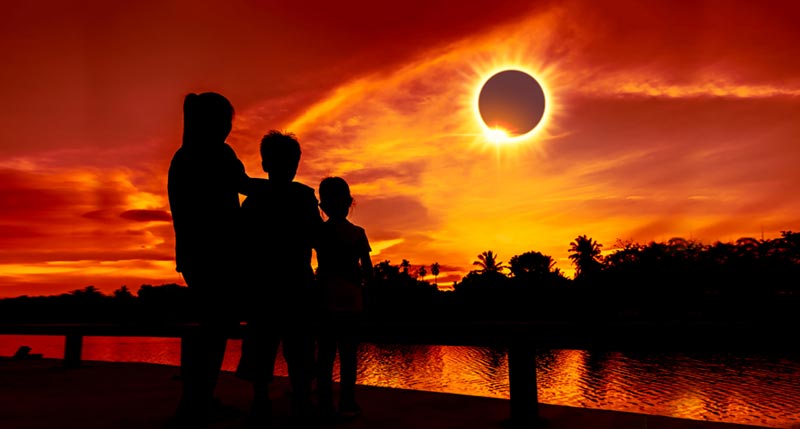As an optometric practice, we understand the excitement around the upcoming total solar eclipse on April 8, 2024. Many major U.S. cities will be in total darkness when the moon passes directly between the Earth and the sun that day, including Dallas, Little Rock, Indianapolis and Cleveland. It’s a relatively rare event – with totality and its view of the wispy corona of the sun occurring only once every 400 years or so in any given location on Earth. So you don’t want to miss it!
In most of the U.S., at least a partial eclipse will be visible on the afternoon of Monday, April 8. To explore what your view of the eclipse will look like, check out Eclipse Central and enter your city name. For example, here’s how the eclipse will appear in Charlotte, NC.
Witnessing this celestial event can be a breathtaking experience, but it’s crucial to prioritize eye safety while doing so.
Here are 8 tips to guide you in viewing the eclipse with your eye safety as the priority:
- Use Certified Eclipse Viewing Glasses – Not Regular Sunglasses
While your regular sunglasses protect your eyes from the sun’s harmful UV rays on a daily basis, viewing an eclipse requires next-level eye protection. If you want to look directly at the sun as the moon eclipses it, invest in a pair of eclipse glasses that meet the ISO 12312-2 international safety standards. These glasses are specially designed to filter out harmful ultraviolet, visible, and infrared radiation, allowing you to look safely at the sun during the eclipse. Avoid using regular sunglasses or homemade filters, as they do not offer adequate protection.
- Inspect Your Certified Eclipse Glasses for Damage
Before using eclipse glasses that you may have stored after viewing previous eclipses, carefully inspect them for any signs of damage, such as scratches, cracks, or punctures. Even minor imperfections can compromise their effectiveness and pose a risk to your eyesight. If you notice any damage, discard the glasses immediately. It’s not worth risking any damage to your vision!
- Keep Glasses On at All Times During The Eclipse
When viewing the solar eclipse, keep your eclipse glasses on at all times while looking directly at the sun. Resist the temptation to remove them, even for a brief moment, as this can result in severe eye damage. And, parents: Supervise your kids closely to ensure they keep their glasses on properly. Their young eyes are more susceptible to UV damage than your adult eyes.
- Practice Proper Viewing Technique
To safely view the eclipse, put on your eclipse glasses before you walk outside, or put them on with your back to the sun while outside. You can look directly at the sun through the glasses, but don’t look at the sun through any unfiltered devices such as cameras, binoculars, or telescopes. These devices can magnify the sun’s rays and cause irreversible eye damage if not equipped with appropriate solar filters.
- Use Pinhole Projection or Optical Projection
If you don’t have access to certified eclipse glasses, consider using the pinhole projection or optical projection methods as safe alternatives. These can be a fun project to do with your kids. For pinhole projection, poke a small hole in an index card or piece of cardboard and hold it between the sun and a second piece of cardboard or a flat surface. This will project an image of the eclipsed sun onto the surface, allowing you to view it indirectly. Remember to always keep your back to the sun when using a pinhole projector, and never look at the sun directly through the pinhole.
- Watch Live Streams or Broadcasts
If it’s cloudy in your city, or if you don’t have the proper viewing glasses or methods, don’t lose hope! You can still enjoy the celestial show through eclipse live streams or broadcasts, and you may even get a better view of it that way. Many organizations will offer high-quality broadcasts of the eclipse, allowing you to enjoy the spectacle from the safety of your home.
- Educate Friends and Family About Eye Safety
Share these tips about the importance of eye safety during the solar eclipse among your friends, family, and community. Encourage them to use certified eclipse glasses or alternative viewing methods to protect their eyesight. The April 8 total solar eclipse will be visible to about 32 million people in 15 states in a 115-mile-wide path in the U.S., plus millions more who will be able to see varying percentages of partial eclipse. Let’s help ensure that everyone enjoys the eclipse safely.
- Schedule a Post-Eclipse Eye Exam
Now that you’re focused on eye safety, why not take it to the next level and schedule your annual eye exam with us this month? After you take all of the precautions to view the eclipse safely, you want to make sure your eyes stay healthy to enjoy all of life’s exciting future events, too.
Enjoy the April 8, 2024 solar eclipse – we hope it is a memorable and safe experience for you and your family.
